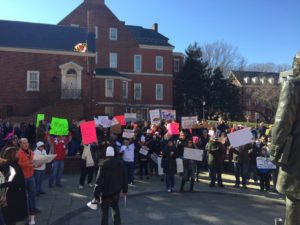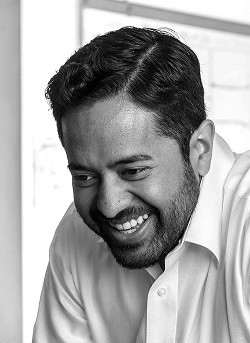A coalition of teachers, immigration advocates, members of religious minority groups, and others joined together to call on Governor Hogan to repudiate President Trump’s agenda. Here are my remarks from the rally. Coverage: WTOP, Capital Gazette, WaPo
My name’s Samir Paul, and I’m a proud Maryland teacher and union member. Or, as Larry Hogan likes to put it, I’m a thug. And like most thugs, I get to my classroom before the sun rises and I’m often there after the sun sets. Like most thugs, I turned down big private sector salaries because I love the look on a kid’s face when she finally “gets” it. And maybe most thuggishly of all, I show up to work every day because I believe that public schools are the best possible incubators for American democracy.
up to work every day because I believe that public schools are the best possible incubators for American democracy.
Governor Hogan and President Trump look at my students and see dollar signs for private schools and for big business friends. But I don’t make consumers in my classroom — I make citizens. I teach my students to challenge ideas but to always respect people. I teach them that being smart is cool, but only when you use your gifts to serve others. And I teach them that nothing makes powerful men more nervous than a young person who loves this country enough to stand up to a bully.
And I do all of this in a public school that takes ALL kids — black, white, brown; rich or poor; boy or girl; Christian or Jewish or Muslim or atheist; Democrat or Republican; gay, straight, trans; born here or immigrant; documented or not. It’s not that our school HAS to take every child — we GET to take every child.
The Trump-Hogan agenda for public education is to take money out of schools like mine to pay for schools that DON’T serve every student. It’s not that private schools are bad; it’s just that if there are unmet needs in the public schools those taxpay er dollars should stay where they belong. Last year, it was $5 million for private school vouchers. This year it’s $7 million dollars. I don’t need to draw you a graph to tell you what’s next.
er dollars should stay where they belong. Last year, it was $5 million for private school vouchers. This year it’s $7 million dollars. I don’t need to draw you a graph to tell you what’s next.
Look at President Trump’s pick for secretary of education. Betsy DeVos has never attended a public school, sent her kid to a public school, taught in a public school, or run a public school. But she DID give millions of dollars to President Trump and Republican senators. Well let me tell you — her nomination may have been bought and sold, but Maryland’s public schools won’t be!
I don’t believe Governor Hogan is a bad man. But it’s going to be too easy over these next two years — and I do believe Governor Hogan will only be sitting in that chair for two more years — it’s going to be easy over these next two years to get swept up in the dark deceptions of our national politics. So I hope he’s listening when I say this: Governor Hogan, join us in beating back the Trump agenda. Keep public schools public. Call a Republican friend of yours in the US Senate and convince them to vote no on Betsy DeVos. Make sure every student — no matter where they’re from, what they look like, whom they love, or whom they worship — feels safe and valued in an excellent public school. History alone will judge how we respond to the coming threats. I hope we’ll look back and be able to say that you stood with students and teachers to do right by Maryland’s public schools.

 room full of other people — something electric that is hard to capture if everyone has already seen the big idea independently and you’re just fine-tuning it as a group.
room full of other people — something electric that is hard to capture if everyone has already seen the big idea independently and you’re just fine-tuning it as a group.
